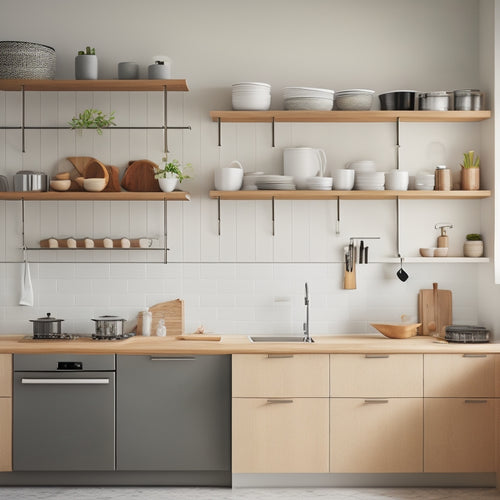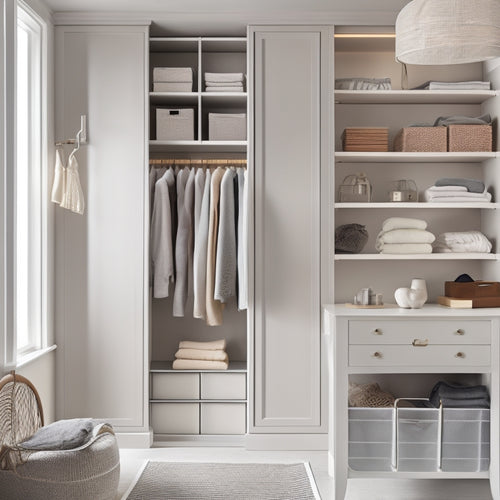
7 Best Systems for a Seamless Home Management Binder
Share
You're looking for a thorough system to streamline your household management, and a well-organized home management binder is the key to achieving that. Start by implementing a versatile calendar system that syncs digital and physical calendars. Next, create a task and chore management system with daily task lists, chore assignments, and routine schedules. Then, organize your budget and expenses using the envelope system or zero-based budgeting. Don't forget to schedule household maintenance, plan meals and groceries, store important documents, and plan for seasonal and holiday events. With these 7 systems in place, you'll be on your way to a seamless home management binder - and a more organized, stress-free life just ahead.
Key Takeaways
• Implement a customizable calendar system that incorporates both digital and physical tools for seamless access and synchronization.
• Establish a task and chore management system that includes daily task lists, chore assignments, and routine schedules to promote productivity and accountability.
• Organize budget and expense tracking using the envelope system or zero-based budgeting to stay on top of finances and identify areas for improvement.
• Create a household maintenance schedule to ensure essential tasks are completed on time, preventing major problems and reducing stress.
• Designate a central location for vital documents, both physical and digital, to maintain easy access and reduce clutter.
Customizable Calendar System
Create a calendar system that revolves around your unique needs and preferences by incorporating a mix of digital and physical tools to stay organized and on top of your schedule. This hybrid approach allows you to leverage the strengths of both digital and physical calendars.
For instance, you can use a digital calendar on your phone or computer to set reminders and notifications, while also maintaining a physical calendar in your home management binder for a visual overview of your schedule.
To take your calendar system to the next level, incorporate color coding to categorize different types of events or tasks. For example, you can use red for work-related events, blue for personal appointments, and green for family activities. This visual system helps you quickly identify the type of event and make informed decisions about your time.
Digital integration is also key to a seamless calendar system. Consider syncing your digital calendar with your physical one to make certain that you always have access to your schedule, regardless of whether you're at home or on-the-go.
Task and Chore Management
When you create a task and chore management system, you'll want to start by establishing daily task lists that outline what needs to be done each day.
Next, you'll assign chores to specific household members, making sure everyone knows their responsibilities.
Daily Task Lists
How do you currently tackle your daily tasks and chores, and are you satisfied with your current system for staying on top of them? Having a solid daily task list system in place can make a huge difference in your productivity and overall sense of control.
To help you get started, here are some Morning Routine productivity hacks to explore:
| Morning Routine Hacks | Benefits |
|---|---|
| Wake up 30 minutes earlier | More time for self-care and planning |
| Prioritize your most important task | Focus on what needs to be done first |
| Use a planner or app to stay organized | Keep track of tasks and deadlines |
| Break tasks into smaller chunks | Make tasks feel less overwhelming |
Chore Assignments Made
By dividing household responsibilities among family members, you're ensuring a fair share of workload and fostering a sense of teamwork. This approach not only lightens the load but also promotes personal accountability. When everyone knows their tasks, they're more likely to take ownership and complete them on time. Chore assignments made visible through a home management binder help family members understand their roles and responsibilities, reducing confusion and conflict.
In addition, clear chore assignments can improve family dynamics by encouraging open communication and collaboration. By involving family members in the assignment process, you can identify their strengths and weaknesses, and allocate tasks accordingly. This approach helps to build trust and respect among family members, as they work together to maintain a clean and organized home.
With chore assignments made, you can also track progress, identify areas for improvement, and make adjustments as needed. By incorporating this system into your home management binder, you'll be well on your way to a more harmonious and productive household.
Routine Schedules Set
You establish a sense of control and direction in your home by setting routine schedules for tasks and chores, ensuring that everything runs smoothly and efficiently. A well-planned routine helps you stay on top of daily tasks, freeing up time for more important things.
Start by creating morning routines that set the tone for the day. This could include exercise, meditation, or simply enjoying a cup of coffee in peace.
Next, establish bedtime rituals that signal the end of the day. This might involve reading a book, taking a warm bath, or practicing gentle stretches.
By implementing these routines, you'll create a sense of structure and rhythm in your home. This, in turn, will help you manage tasks and chores more effectively, reducing stress and increasing productivity. Be sure to tailor your routines to your unique needs and preferences, making adjustments as needed.
With routine schedules in place, you'll be amazed at how much more efficiently your home runs.
Budget and Expense Tracking
Your home management binder's budget and expense tracking section serves as a financial blueprint, providing a clear picture of your income, expenses, and areas for improvement. This section helps you stay on top of your finances, making it easier to create a budget that works for you. Two popular methods for budgeting are the envelope system and zero-based budgeting. The envelope system involves dividing your expenses into categories, such as groceries and entertainment, and allocating a specific amount of cash for each category. Zero-based budgeting, on the other hand, involves starting from a "zero balance" and allocating every single dollar towards a specific expense or savings goal.
Here's a breakdown of how you can organize your budget and expense tracking:
| Category | Amount |
| Groceries | $500 |
| Entertainment | $200 |
| Savings | $1000 |
Household Maintenance Schedules
Maintaining a clean and organized home requires regular upkeep, which is where a household maintenance schedule comes into play, helping you stay on top of tasks and prevent minor issues from becoming major problems.
By creating a schedule, you'll guarantee that essential tasks are completed on time, reducing the risk of costly repairs and replacements. Your schedule should include regular checks on critical systems like plumbing, HVAC, and electrical systems. You should also keep track of appliance records, including warranties, manuals, and maintenance histories. This will help you identify potential issues before they become major problems.
In addition to regular checks, incorporate seasonal checks into your schedule. For example, you'll want to inspect and clean your gutters in the fall, and inspect your roof for damaged or missing shingles in the spring.
Meal Planning and Grocery Lists
When it comes to meal planning and grocery lists, you're likely tired of scrambling to figure out what's for dinner each night or dealing with last-minute takeout runs.
To take control of your meal planning, you'll want to establish strategies that work for you, such as planning around sales or using a 'cook once, eat twice' approach.
Meal Planning Strategies
Create a meal planning strategy that suits your lifestyle by identifying your dietary preferences, cooking skills, and scheduling constraints to make sure you're cooking meals that are both enjoyable and realistic. This will give you Meal Freedom, allowing you to cook what you want, when you want, without feeling restricted.
You can find Recipe Inspiration online, through cookbooks, or by experimenting with new ingredients. Consider your cooking skills and don't be afraid to start with simple recipes and gradually move to more complex dishes.
Be honest about your schedule and plan meals that can be prepared in advance or cooked quickly on busy days.
When developing your strategy, think about your lifestyle and what works best for you. Do you prefer cooking in bulk or preparing individual meals? Do you have any dietary restrictions or allergies that need to be considered?
Weekly Menu Planning
Now that you've established a meal planning strategy that suits your lifestyle, you're ready to put it into action by planning your weekly menu, generating a grocery list, and streamlining your kitchen workflow. This is where the rubber meets the road, and you'll start to see the benefits of your meal planning strategy.
To plan your weekly menu, consider the following factors:
| Day | Meal | Kid Preferences/Dietary Restrictions |
|---|---|---|
| Mon | Chicken Parmesan | No peanuts, gluten-free bread |
| Tue | Veggie Stir-Fry | Vegan, no soy sauce |
| Wed | Tacos | Gluten-free shells, no dairy |
| Thu | Baked Chicken | Low-sodium, no MSG |
When planning your menu, take into account your family's kid preferences and dietary restrictions. This will make sure that everyone is on board with the meal plan and that you're catering to their needs. By considering these factors, you'll avoid last-minute changes and reduce food waste. With your weekly menu planned, you can now generate a grocery list and start cooking!
Grocery List Organization
Organize your grocery list by categorizing items into groups like produce, meats, dairy, and pantry staples to make sure you don't miss anything at the store. This list categorization system helps you visualize your shopping trip and guarantees that you don't forget essential items.
You can also group similar items together, such as breakfast essentials or snack items, to make your shopping experience more efficient.
When you're at the store, use your categorized list to navigate the aisles with ease. Start with the produce section, then move on to meats, dairy, and so on. This aisle navigation approach saves you time and energy by reducing the need to backtrack or search for specific items.
Additionally, you can use a 'store layout' approach, where you organize your list according to the layout of your local grocery store. This way, you can shop in a logical order, reducing the time spent in the store and minimizing impulse purchases.
Important Document Storage
You'll want to designate a central location in your home management binder for storing important documents, such as insurance policies, property deeds, and identification records. This will guarantee that you can easily access and retrieve vital documents when needed. Consider using a secure vault or a fireproof safe to protect sensitive documents from damage or loss.
In addition to physical storage, consider implementing a digital filing system to store electronic copies of your important documents. This will provide an extra layer of security and make it easier to share documents with others if needed.
You can use cloud-based storage services like Google Drive or Dropbox to store your digital files. Organize your digital files into clear and concise folders and labels, making it easy to find what you need quickly.
Seasonal and Holiday Planning
By incorporating seasonal and holiday planning into your home management binder, you'll create a centralized hub for tracking important dates, planning celebrations, and tackling tasks related to specific times of the year. This section will help you stay organized and focused, ensuring that you never miss a special occasion or deadline.
| Seasonal Tasks | Holiday Planning |
|---|---|
| Spring: Clean out closets, Plant garden | Easter: Plan Easter egg hunt, Prepare Easter baskets |
| Summer: Plan summer vacation, Schedule outdoor activities | 4th of July: Plan BBQ, Prepare patriotic decor |
| Fall: Plan Halloween costumes, Start holiday gift wrapping | Thanksgiving: Plan menu, Create guest list |
With this section, you'll be able to plan ahead for holidays and seasons, making the most of your time and energy. You can include notes on decor inspiration, gift wrapping ideas, and even recipes for special occasions. By having all this information in one place, you'll feel more in control and prepared for whatever the season brings. By incorporating seasonal and holiday planning into your home management binder, you'll be able to relax and enjoy the festivities, knowing that everything is taken care of.
Frequently Asked Questions
Can I Use a Digital Tool or Only a Physical Binder?
You can definitely use a digital tool, like cloud storage, to organize your home management system, or opt for a physical binder - or, consider a hybrid approach that combines both for maximum flexibility and accessibility.
How Do I Get My Family Members to Use the System?
To get your family members on board, you'll need to establish accountability strategies, like assigning tasks and tracking progress, to encourage habit formation and make the system a seamless part of your daily routine.
What if I'm Not Organized or Tech-Savvy?
"You're not alone if you feel like a hot mess! Don't worry, building confidence in your organizational skills takes time. Start with simple strategies like categorizing tasks and creating a routine, and you'll be a pro in no time!"
Can I Customize the System for My Unique Household Needs?
You can tailor a home management system to fit your unique needs by taking a personalized approach, using an adaptive framework that adjusts to your household's rhythms, and incorporating tools that work best for you.
How Often Should I Review and Update My Home Management Binder?
"Are you stuck in a rut, wondering when to dust off your home management binder? Review and update it every 3-6 months, ideally during seasonal refreshes or when life changes occur, to keep your system fresh and functional."
Related Posts
-

Tiny Kitchen Big Storage: Space-Saving Ideas
You can transform even the smallest of kitchens into a haven of functionality and style by utilizing every inch of av...
-

Mastering Small Closet Organization: Proven Strategies Unlocked
You're about to reveal the secret to transforming your small closet into a functional haven, where every item has its...
-

Streamline Your Space: Decluttering Strategies for Minimalists
You're wasting time and energy maneuvering through cluttered spaces, which is why streamlining your space is essentia...


